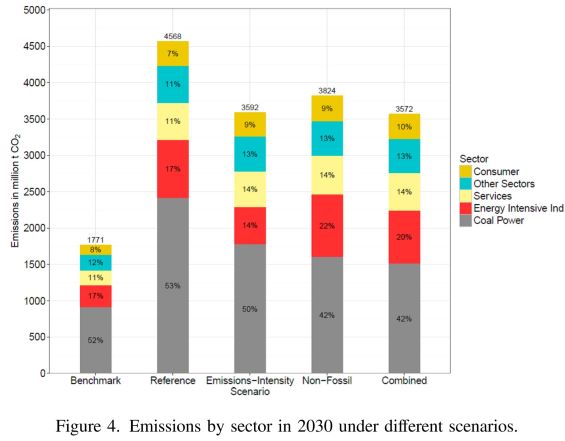

Massachusetts Institute of Technology (MIT) researchers in their study have concluded that combining a countrywide carbon price with standard renewable portfolio scenario (RPS) is far more politically viable as it would significantly bring the price per ton of CO2 down to $6.17/tCO2 from $23.38/tCO2 (in 2011 U.S. dollars) under a standalone carbon-pricing policy.


The MIT researchers assessed the economic implications of three policy scenarios—carbon pricing, a Renewable Portfolio Standard (RPS), and a combination of both. For the assessment, they developed an economy-wide model of India with energy-sector detail, and applied it to simulate the achievement of each component of the India’s Paris pledge.
They found carbon pricing—imposing an economy-wide emissions reduction policy alone to meet the target emissions intensity—would cost the least to India’s economy.


By contrast, an RPS, which would enforce a minimum level of currently more expensive carbon-free electricity, would have the highest per-ton cost—more than 10 times higher than the economy-wide CO2 intensity policy.
Combining an economy-wide carbon price with an RPS would, however, bring the price per ton of CO2 down to a far more politically viable $6.17/tCO2from $23.38/tCO2 (in 2011 U.S. dollars) under a standalone carbon-pricing policy.
The study in its conclusion also factored in the impact of falling wind and solar energy generation on the scenarios. “The global and national decline in wind and solar costs motivates our inquiry into the interaction of above policy outcomes with varying costs of wind and solar power. As expected, welfare losses under a carbon price plus RPS decrease sharply at lower wind and solar costs and are only slightly higher than those under a pure carbon price at the lowest cost levels that we simulate.” The study further suggested that the declining cost will in fact help in deeper decarbonization of the sectors, “this suggests that declining wind and solar costs may pave the way for more aggressive decarbonization policies in the future, without compromising India’s economic development objectives.”
If wind and solar costs decline significantly, the cost to the economy would decrease considerably; at the lowest wind and solar cost levels simulated, the model projects that economic losses under a carbon price with RPS would be only slightly higher than those under a standalone carbon price.
Thus, declining wind and solar costs could enable India to set more ambitious climate policies in future years without significantly impeding economic growth.
This work was supported in part by a research fellowship provided to Arun Singh by the MIT Tata Center for Technology and Design with Valerie Karplus and Niven Winchester (MIT joint program principal research scientist and also a co-author of the study), the economy-wide model of India enables researchers to gauge the cost-effectiveness and efficiency of different technology and policy choices designed to transition the country to a low-carbon energy system.
The study was first published in Climate Change Economics Journal.
To read the entire study click MIT study- Evaluating India’s Climate Targets.
India’s ethanol initiative has helped India save Rs Rs. 1,26,210 crore in foreign exchange by…
Noida-based green energy leader NexGen Energia Ltd has secured a $1 billion equity investment commitment…
As Odisha takes firm steps toward a just transition from fossil fuels to renewable energy,…
Bio-Integrated cladding for greener cities, an innovative solution by a 29-year-old Indian architect, has won…
In a novel move, Farmwatt Innovation has launched a long-term training and capacity-building initiative focused…
State owned Bharat Petroleum Corporation Ltd (BPCL) has joined hands with GPS Renewables Pvt Ltd…